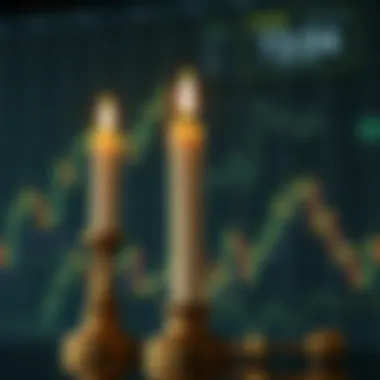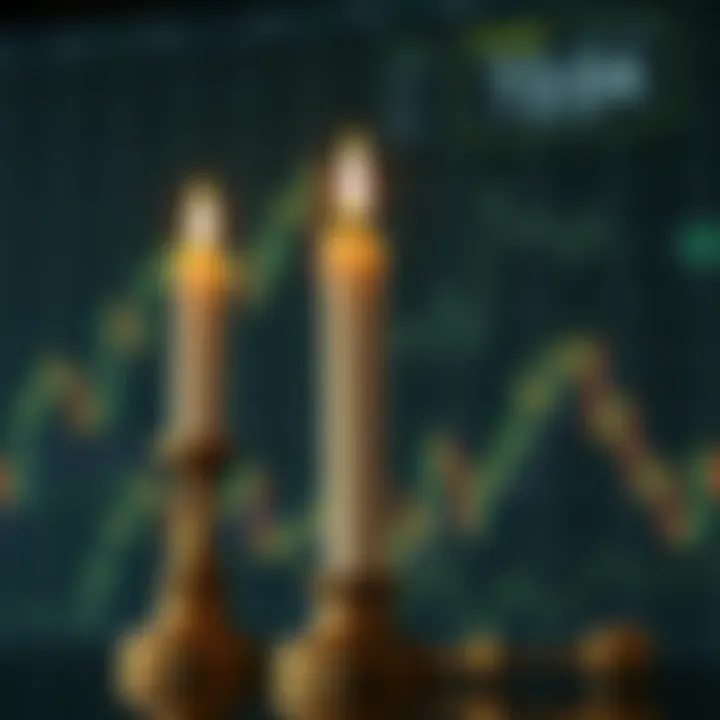Understanding Candlesticks in Financial Trading


Intro
In the fast-paced world of financial trading, candlestick patterns stand as vital tools used by traders to interpret market sentiment and predict future price movements. Their prominence in various trading strategies can't be overstated. This guide seeks to peel back the layers on these intriguing visual aids, allowing both novice and seasoned investors to grasp their profound significance.
Candlestick patterns, for those who might be unfamiliar, serve as graphical representations that encapsulate a specific time frame of price activity. Each candlestick indicates the open, close, high, and low prices for a particular period, offering insights into potential market direction. As we navigate through the intricacies of these patterns, we'll delve into their historical origins, the mechanics of their structure, and how traders decode them to make informed decisions.
Key Terms and Definitions
Investment Dictionaries
Understanding the terminology in finance is crucial for effective trading. Here are some key terms you might encounter:
- Candlestick: A graphical representation that shows the open, close, high, and low prices within a specified time frame.
- Bullish Signal: A pattern suggesting that the price is likely to rise.
- Bearish Signal: A formation indicating an impending price drop.
- Trend: The general direction in which the market or the price of an asset is moving.
Panicking over jargon can be inevitable for new investors. The more you familiarize yourself with these terms, the less daunting the trading landscape becomes.
Terms Related to Stocks
Understanding stock-related terms enhances your trading capabilities. Some to consider include:
- Share: A unit of ownership in a company, representing a claim on a part of the company’s assets and earnings.
- Market Cap: The total market value of a company's outstanding shares of stock; a measure often used for assessing company size.
- Volatility: Refers to the degree of variation in trading prices over time, indicating the level of risk associated with a particular investment.
"A wise trader not only understands the market but also masters the language of finance."
Expert Advice
Tips for Beginner Investors
Every journey begins with the first step. Here are some pointers for budding traders:
- Start Small: Engage with minimal investments to grasp how candlesticks function in practice.
- Study Historical Patterns: Familiarize yourself with past market behaviors, as these can serve as guides for future trades.
- Combine Strategies: Don’t rely solely on candlesticks; integrate them with other analysis tools like moving averages for a holistic view.
Understanding Risk Tolerance
Risk tolerance is paramount in trading. Understanding your own capacity for risk will guide your trading choices effectively. Consider these factors:
- Investment Goals: Determine what you aim to achieve from trading—long-term wealth vs. short-term profits.
- Financial Situation: Assess your available capital; ensure that your investments do not jeopardize your financial stability.
- Emotional Resilience: Trading can be an emotional rollercoaster. Gauge how you respond to losses and gains, as this influences decision-making significantly.
In summary, grasping the basics of candlestick patterns and accompanying lexicon can facilitate smarter trading techniques while mitigating risks. As we continue this exploration, we’ll dissect specific candlestick formations and their implications on market movements.
Prelims to Candlesticks
In the realm of financial markets, the importance of candlestick patterns cannot be overstated. These visual tools serve as powerful indicators that encapsulate price movements within specific periods, giving traders insights into market sentiment and potential future activities. By analyzing candlestick formations, investors gain a nuanced understanding of market dynamics, which is key to developing effective trading strategies.
Definition and Purpose
Candlesticks, at their core, are graphical representations that display four essential price points: open, high, low, and close of a trading period. Each candlestick provides a snapshot of price action, formed by the interplay of buyers and sellers. When one looks at a candlestick chart, a multitude of stories unfolds. A green (or white) candlestick typically signifies upward price movement, whereas a red (or black) candlestick indicates a downward trend.
The primary purpose of candlestick patterns is to inform traders about market sentiment. They help in detecting shifts in trading momentum and revealing potential reversals before they occur. Understanding these patterns is crucial, especially in volatile markets where swift decision-making is paramount. Recognizing the subtle nuances behind each shape can lead to better entry and exit points, ultimately improving trading outcomes.
Historical Context
The origins of candlestick charting trace back to Japan in the 17th century. A rice trader named Munehisa Homma pioneered these techniques, utilizing them to track the price movements of rice in local markets. His techniques employed visual aids, which painted a vivid picture of market sentiment based on fluctuations in price over time. Today, this age-old method has transcended its agricultural roots, becoming a robust tool used in financial markets globally.
As financial markets evolved, the incorporation of candlestick patterns became increasingly relevant. From the traditional open outcry markets to modern digital exchanges, the candlestick chart remains a staple for traders of various styles and methodologies. Its historical significance serves as a testament to its enduring effectiveness, helping traders navigate complex market landscapes with relative ease.
Candlestick patterns provide a unique blend of insights and intuition, making them indispensable for today’s investor seeking to understand the underlying psychology of market movements.
The Anatomy of a Candlestick
Understanding the anatomy of a candlestick is crucial for any trader looking to unlock the secrets of market behavior. A candlestick isn't merely a visual aid; it's a powerful representation of price action, packed with information that reveals the underlying sentiment of the market. Each candlestick reflects a specific timeframe—whether that’s a minute, an hour, or a day. Analyzing its structure can guide traders toward informed decisions, making the anatomy of a candlestick an essential topic in trading analysis.
Body, Wicks, and Shadows Defined
A candlestick consists primarily of three key components: the body, wicks, and shadows. The body illustrates the difference between the opening price and the closing price for that period. A filled or red body indicates a closing price lower than the opening price, signifying bearish behavior. On the other hand, a hollow or green body shows the closing price was higher than the opening, indicating bullish momentum.
Wicks, often called shadows, protrude from the body and represent the highest and lowest prices during that timeframe. The top wick indicates the highest price reached, while the bottom wick marks the lowest point. Understanding these elements is akin to reading between the lines of a narrative—traders can gauge whether buyers or sellers dominated the period. The length of the wicks can signify market volatility.
Quote: "Candlesticks tell a story, reflecting the constant ebb and flow of market sentiment, illuminating the path forward for astute traders."
In summary, the body's color and size, paired with the lengths of the wicks, yield insights into price movement and market psychology. Cultivating the skill to interpret these aspects can markedly elevate trading strategies.
Open, High, Low, and Close
In every candlestick, four critical price points unravel the narrative: open, high, low, and close. These four points summarize price movement in a concise yet comprehensive manner. The opening price marks where the market began for that specific period. The high and low indicate the range within which the asset traded, revealing volatility and potential areas of support or resistance.
The closing price, often regarded as the most significant, showcases the final sentiment of traders before the period ends. Here’s an insightful way to encapsulate these points:


- Open: The starting price when the trading period initiates.
- High: The highest price reached during the period, indicating maximum bullish sentiment.
- Low: The lowest price observed, reflecting bearish pressure.
- Close: The final price at period end, embodying the prevailing market sentiment.
When traders evaluate these points, they can craft a more informed perspective on the market's current conditions. For example, a candle with a long body and minimal wicks typically suggests strong conviction from buyers or sellers, while a candle where the open and close prices are nearly the same could indicate indecision.
Reading Candlestick Patterns
Reading candlestick patterns is essential for anyone involved in financial trading. These patterns not only reveal the psychology behind market movements but also provide traders with insights that go beyond mere numerical analysis. By identifying trends, reversals, and market sentiment visually, traders can better position themselves to make informed decisions. Understanding these patterns forms the backbone of effective trading strategies, aligning traders’ actions with potential price movements.
Bullish Patterns
Bullish patterns are indicative of a rising price trend, signaling potential buying opportunities. Within this category, there are several noteworthy patterns that traders often utilize.
Engulfing Patterns
Engulfing patterns occur when a small candlestick is followed by a larger candlestick that completely envelops the previous one. This formation often suggests a strong shift in momentum. The key characteristic of engulfing patterns is their ability to indicate a potential reversal from bearish to bullish sentiment. Traders often find this pattern beneficial due to its clarity and decisiveness; it represents a strong commitment from buyers to re-enter the market. However, traders should be cautious, as the absence of other confirming signals may lead to false hopes.
Hammer
The hammer pattern features a small body located at the upper part of the price range, accompanied by a long lower shadow. This formation often appears at the bottom of a downtrend, suggesting that buyers are beginning to assert control after a bearish phase. The hammer's key characteristic is its representation of the rejection of lower prices, indicating potential bullish momentum. Its simplicity makes it a popular choice; however, relying solely on it without further confirmation can sometimes lead to incorrect conclusions.
Morning Star
The morning star pattern is a three-candle formation that signals a potential reversal. It consists of a long bearish candle, followed by a small-bodied candle, and finishes with a strong bullish candle. Traders often see the morning star as a clear indication of a shift in market sentiment, from sellers to buyers. This pattern is particularly valuable because it combines the influence of multiple candles, helping to safeguard against false signals. Still, like any pattern, it’s prudent to consider additional market context before acting.
Bearish Patterns
Bearish patterns signal the potential for price declines and offer insights into when to sell or short an asset. They serve as crucial indicators for traders looking to navigate the market with caution.
Engulfing Patterns
Similar to bullish engulfing patterns, bearish engulfing patterns consist of a small bullish candle followed by a larger bearish candle that engulfs the previous one. This formation often suggests a significant reversal from bullish to bearish sentiment. The effectiveness of bearish engulfing patterns lies in their ability to signal a strong shift in market control. Traders appreciate this pattern for its clarity, but it is essential to confirm the signal with volume and overall market conditions to avoid falling into traps.
Shooting Star
The shooting star is characterized by a small body at the lower end of the trading range and a long upper shadow. This pattern usually appears at the top of an uptrend, suggesting that buyers attempted to push prices higher but were ultimately rejected. The shooting star’s key characteristic is its potential to indicate a strong bearish reversal. Its effectiveness is enhanced when coupled with high trading volume, but caution is advised as similar formations can be misleading if not contextualized.
Evening Star
The evening star consists of three candles—a long bullish candle, a small-bodied candle, and a long bearish candle. This pattern generally indicates a significant reversal from a bullish trend to a bearish one. The evening star's unique feature is its visual clarity, which makes it easy to identify. Its advantages include a clear signal of market sentiment change, though, like many patterns, it requires further confirmation when utilized to minimize risk.
"Understanding candlestick patterns is not just about recognizing shapes but about decoding the emotions that drive market movements."
Through a clear grasp of these patterns, traders can better navigate the often tumultuous waters of financial markets. It’s crucial to integrate this knowledge with market fundamentals and broader economic indicators to form a well-rounded trading strategy.
Complex Candlestick Patterns
Complex candlestick patterns are among the most nuanced and telling indicators in trading. They offer a more sophisticated level of analysis compared to single candlestick formations, encapsulating the psychology and sentiment of the market within multiple price movements. Understanding these intricate patterns helps traders identify potential reversals and continuations more accurately. Their relevance lies not just in predicting price movements, but also in comprehending the overall market context, which can be crucial for making informed trading decisions.
Doji Variations
Doji patterns are unique in that they represent indecision in the market with their characteristic appearance. Each doji indicates a balance of buying and selling pressure, offering insight into possible future movements. Let’s take a closer look at the different variations and their significance, starting off with the standard doji.
Standard Doji
The standard doji is a bellwether of market equilibrium. Notably, it appears when a security opens and closes at the same price or nearly the same price, producing a small body with lengthy wicks on both ends. As a simple yet impactful pattern, it signals potential reversals or a pause in the prevailing trend. Traders often favor this pattern because it encapsulates a moment of indecision that could lead to future shifts.
However, relying on a standard doji alone can be misleading, because the subsequent price action is vital to confirm any anticipated move. Its advantage is its clarity, yet its disadvantage lies in its potential for misinterpretation without contextual analysis.
Dragonfly Doji
Moving on to the dragonfly doji, this variation is particularly significant when it appears at the end of a downtrend. Characteristically, it has a long lower shadow and no or very little upper shadow, which reflects that buyers have stepped in to push the price back up after a dramatic drop. This signaling of bullish intent makes the dragonfly doji a popular choice among traders looking for reversal signs.
Its unique feature is the way it highlights buyer strength at a crucial moment; this sensitivity can be advantageous in identifying potential bullish movements. Yet, caution is warranted, as the absence of substantial buying pressure in following sessions may render the dragonfly doji ineffective.
Gravestone Doji
In contrast, the gravestone doji presents a bearish outlook, indicating potential selling pressure. It features a long upper shadow with little to no lower shadow. This candlestick suggests that buyers pushed prices up significantly during the session, but sellers overwhelmed them by the close, driving the price back down. It’s crucial when observing the gravestone doji to consider its context, particularly if it appears after an uptrend, as it may signal that momentum is flagging.
The notable characteristic of the gravestone doji provides traders with insight into the changing dynamics of buyer-seller sentiment. Despite its potential to indicate reversals, it can sometimes lead to false signals, especially if traded without additional confirmation from other candlestick patterns or indicators.
Three-Candle Patterns
Three-candle patterns build on the complexity of analysis by considering the interplay among three successive candlesticks. They often provide stronger signals than individual candlesticks, aiding traders in discerning market sentiment with greater precision. The patterns that emerge from these formations can illustrate particularly emphatic shifts in market trends, whether bullish or bearish.
Three White Soldiers


Three white soldiers signal a strong bullish reversal. This pattern consists of three consecutive bullish candles, each closing higher than the previous. The progressive ascendance signifies a surge of buyer activity, which can lead traders to view it as a robust indicator of bullish sentiment.
It's beneficial for traders seeking to capitalize on upward movements, but risks remain. If the pattern forms in a predetermined resistance area, it may face hurdles that could negate the upward momentum, leading to potential losses.
Three Black Crows
On the flip side, the three black crows pattern serves as an indicator of declining prices. This formation emerges when three consecutive bearish candles appear, with each closing lower than its predecessor. This pattern provides a compelling illustration of increasing seller dominance, making it a vital consideration for traders positioned on the short side.
However, it’s crucial to evaluate the overall market conditions in conjunction with this pattern; if found in a strongly bullish trend, it can lead to premature exits from winning trades.
Tri-Star
Lastly, the tri-star pattern stands out for its rarity and significance. It typically consists of three stars that appear consecutively, indicating potential reversals, but the first two are dojis. This pattern can signal an impending flip in market direction, whether bullish or bearish, depending on its context. Its charm lies in its predictive power, as it emerges in extreme overbought or oversold conditions, pointing to potential exhaustion in the current trend. Nevertheless, because of its infrequent occurrence, traders must be patient and observant when looking for setups involving the tri-star pattern.
In summary, complex candlestick patterns are invaluable tools in a trader's toolbox. Understanding doji variations and three-candle patterns enhances one's ability to interpret market sentiment. Each of these patterns carries its unique strengths while also presenting specific challenges, emphasizing the need for a holistic approach to trading strategy.
Psychological Insights Behind Candlestick Patterns
Understanding the psychological components behind candlestick patterns adds a layer of depth to trading strategies. At the heart of every transaction lies human behavior, shaped by emotions and collective sentiment. Traders are often swayed by fear, greed, and a myriad of other psychological factors, producing patterns that candlestick analysis seeks to reveal. Recognizing these insights not only enhances one’s comprehension of market movements but also assists in crafting more refined trading strategies.
Market Sentiment Analysis
Market sentiment serves as the pulse of the trading world; it reflects how traders feel about the market's direction, often driving price fluctuations. This sentiment analysis can be deciphered through candlestick patterns, which act almost like a diary of trader emotions. For instance, a series of bullish candlesticks could indicate a growing optimism among traders, while bearish patterns might unveil an underlying anxiety or pessimism.
The symmetry and shape of candlesticks provide a snapshot of market sentiment at any given time. A long green candle, followed by a short candle, might suggest that the buying pressure is weakening, signaling that traders are beginning to think twice about future price increases. Similarly, a red candle following a doji could indicate a potential reversal, suggesting that traders are feeling uncertain and shifting their positions.
Incorporating sentiment analysis into one’s trading tactics helps in establishing entry and exit points based on not just numbers, but also the emotional landscape of the market. As traders, understanding this sentiment equips one to better gauge potential market shifts, allowing for more informed decisions.
The Role of Emotions in Trading
Emotions are the unseen hand guiding countless financial decisions. Fear can lead to impulsive decisions, such as selling during a market dip, while greed may tempt traders to hold onto a position longer than is prudent. This inherently human aspect of trading is critical to consider when analyzing candlestick patterns.
For instance, the emergence of a hammer candlestick in a downward trend often reflects the emotional struggle between bulls and bears. This pattern indicates that buyers are stepping in, providing a glimmer of hope to traders looking for potential reversals. Conversely, the appearance of a shooting star signals that sellers could be gaining strength after a rally, showcasing that fear is beginning to seep into the market.
Moreover, it's important to recognize how group psychology influences individual decision-making. Investors are likely to follow trends, and often, this herd mentality can amplify market movements tremendously.
"Trading isn't just about numbers; it's about people making decisions driven by emotions, and candlestick patterns are reflections of those emotions."
As one navigates the landscape of trading, embracing these psychological insights can result in better outcomes. Integrating emotional intelligence into trading practices could aid in setting realistic expectations, avoiding rash decisions, and ultimately leading to a more balanced approach when utilizing candlestick analysis.
Integrating Candlestick Analysis with Trading Strategies
Understanding candlestick patterns is just one part of the puzzle when it comes to trading effectively. Integrating candlestick analysis into broader trading strategies is crucial for enhancing trading decision-making. This integration offers traders an edge by combining visual price movements with other analytical tools and techniques. By understanding how to effectively blend these elements, traders can develop a more robust analysis framework that enables them to spot trading opportunities with greater confidence.
When it comes to integrating candlestick analysis, traders often need to consider several factors. These include market conditions, the time frame of trading, and individual trading goals. Using candlestick charts, traders identify trends and patterns, but they also need to understand the context in which these signals occur. Not every bullish signal will lead to a profitable trade, especially in volatile markets. Thus, aligning candlestick observations with market trends gives traders a clearer picture of potential price movements.
Candlesticks and Trend Analysis
Each candlestick holds valuable information about the market, but the context is equally important. In trend analysis, traders look for patterns that suggest whether a market is in a bullish or bearish state. Integrating this analysis with candlestick signals allows traders to confirm or discredit their views about market direction.
Candlesticks can help identify whether a trend is gaining strength or is about to reverse. For example, a series of higher highs and higher lows, confirmed by bullish candlesticks, may indicate a strong upward trend. Contrarily, if the market is in a downtrend, an appearance of a bullish pattern can serve as a warning sign. The key lies in pairing candlestick signals with broader trend analysis, making it a powerful tool in forecasting price movements effectively.
Combining Indicators with Candlestick Patterns
The real strength of any trading strategy emerges when combining candlestick patterns with technical indicators. Traders often use these tools to corroborate signals. Some of the most common indicators that work well with candlestick patterns include:
Moving Averages
Moving averages provide a simple yet effective way to smooth out price data over a specific period. This smoothing can help traders identify the underlying direction of the market and filter out noise. The fundamental aspect of moving averages is their ability to illustrate trends clearly, highlighting potential support and resistance levels.
Incorporating moving averages with candlestick analysis becomes crucial because when prices move above a moving average, it signals potential bullish conditions. Conversely, if the price is below the moving average, it might indicate bearish sentiment. One specific feature of moving averages is their lagging nature, meaning they may not react quickly to sudden price shifts. This lag can either be an advantage or a disadvantage, depending on the trading strategy and individual risk tolerance.
Relative Strength Index
The Relative Strength Index (RSI) is another widely used momentum indicator that measures the speed and change of price movements. It scores a price on a scale of 0 to 100, indicating whether an asset is overbought or oversold. This aspect makes RSI particularly beneficial for traders looking to time their entries and exits around candlestick pattern signals.
In synergy with candlesticks, an RSI reading above 70 can suggest that an asset might be overbought, enhancing the signal provided by a candlestick reversal pattern. However, it's vital to understand that while RSI is a robust tool, market conditions can occasionally lead to false signals, and it should never be the sole basis for trading decisions.
Bollinger Bands
Bollinger Bands consist of a middle band, representing a moving average, and two outer bands that show price volatility. The distance between these bands indicates market volatility, allowing traders to assess potential price movements. When integrated with candlestick patterns, Bollinger Bands can add another layer of confirmation to trading signals.
For example, if a bullish candlestick forms at the lower Bollinger Band, it might indicate that the price could rebound. However, it’s important to remember that market movements can be unpredictable, and relying solely on this indicator has its downsides. Traders often find that while they can provide insights into volatility and trend reversals, relying on them without additional confluence can lead to unreliable trades.
Limitations of Candlestick Patterns


Candlestick patterns offer traders valuable insights into market behavior, yet they are not foolproof. Understanding the limitations of these patterns is vital for any trader aiming to enhance their decision-making process. This section delves into two primary limitations: the potential for false signals and how varying market conditions can influence the interpretation of these patterns.
False Signals and Misinterpretations
Candlestick patterns are prone to misinterpretation, which can lead to false signals and poor trading decisions. A trader might spot a bullish engulfing pattern, interpreting it as a sign to buy. However, if the broader trend is bearish, this pattern could lead to significant losses instead. The intricacies of price movements in different contexts often lead to misconceptions.
Factors that contribute to misinterpretation include:
- Context Ignored: Traders sometimes focus solely on the candlestick pattern without considering the broader market context.
- Confirmation Not Used: Relying too heavily on a single candlestick pattern without seeking confirmation from other indicators can be risky.
- Noise in the Market: Volatility can create misleading patterns. A spike in price may produce a candle that looks bullish or bearish, but the surrounding market conditions may not support this movement.
Understanding false signals and how they can misguide a trader is essential. Without due diligence or context, even a well-known pattern can lead to disaster.
"In trading, context is king."
Market Conditions Influence
Market conditions play a significant role in the reliability of candlestick patterns. Different environments, such as trending markets versus ranging markets, can drastically affect the effectiveness of these patterns. A bullish pattern may signal an opportunity during a strong uptrend, but the same pattern might indicate caution in a choppy market.
Consider these influential market conditions:
- Trends: In a strong trend, patterns might have a clearer signal. Yet, in a sideways market, many patterns could produce conflicting signals, causing confusion.
- News Events: External factors, such as news announcements or economic reports, can drastically shift market sentiment, rendering even clear patterns irrelevant.
- Time Frames: The validity of a candlestick pattern can differ dramatically depending on the time frame. A pattern that appears on a daily chart may not hold the same weight on a minute chart.
Traders need to remain vigilant and adaptable to changing conditions. Whether the market is bullish, bearish, or sideways can shape the efefctiveness of any executed candlestick strategy. By being aware of these limitations, traders can make more informed decisions that consider both the potential and the risks of candlestick patterns.
For a deeper insight into candlestick patterns and trading psychology, visit Wikipedia or Investopedia.
Practical Applications of Candlestick Analysis
Candlestick analysis is not just a theoretical exercise. It serves practical purposes that can significantly enhance trading performance. Understanding how to apply candlestick patterns can help traders to make informed decisions, manage risk better, and ultimately improve profitability. By blending psychology and technical analysis, candlesticks provide insights into market sentiments that can prove invaluable for traders.
- Enhanced Decision-Making: By analyzing candlestick patterns, traders can quickly gauge market sentiment. This helps in making quicker and more effective trading decisions.
- Visual Representation of Market Trends: Candlesticks offer a clear visual cue about price movements, allowing traders to spot bullish and bearish trends at a glance.
- Integration with Risk Management: A solid candlestick strategy can be integrated with risk management techniques, allowing for better control over losses. This proactive approach helps traders mitigate risks in volatile markets.
- Versatile Across Timeframes: Whether a trader is focused on short-term day trading or long-term investments, candlestick analysis maintains its relevance. Traders can adapt their approach based on various timeframes, such as minutes, hours, or days.
Case Studies of Successful Trades
Understanding real-world applications of candlestick analysis can provide traders with practical insights. One of the most revered examples includes the famous trader George Soros, known for his market wizardry. During the Black Wednesday of 1992, Soros employed candlestick analysis to spot a bullish reversal, enabling him to bet against the British Pound successfully. His suitable timing, coupled with effective risk management strategies, saw him earn significant profits that day.
Moreover, consider the case of a hypothetical trader, Jane, who recognized a classic bullish engulfing pattern on the euro-dollar currency pair. After confirming the pattern with volume analysis, she entered a long position, setting her stop-loss below the recent swing low. Jane’s meticulous risk management plan, paired with her understanding of market psychology, led her to reap robust gains as the market rallied.
The beauty of these case studies lies in their applicability; they highlight the essence of not just recognizing patterns, but also formulating strategies built upon these insights.
Developing a Personal Trading Plan
Developing a personal trading plan tailored to individual needs is crucial for success. A trading plan should incorporate candlestick analysis to create a comprehensive approach.
Setting Entry and Exit Points
Setting entry and exit points is perhaps the backbone of any trading strategy. It determines when to buy or sell based on market conditions. When using candlestick patterns to set these points, the trader can establish a plan rooted in technical analysis. For instance, a trader might decide to enter a position following a bullish engulfing pattern while setting an exit point at the next resistance level identified through prior price action.
Key Characteristic: The effectiveness of setting these points drastically increases when you integrate candlestick signals with other indicators like volume or moving averages.
Benefits: By using candlestick formations, traders can identify the psychological thresholds of market participants, improving their odds of success. This approach offers not just clarity in decision-making but acts as a buffer against emotional trading decisions.
Unique Feature: The most remarkable advantage of determining precise entry and exit points using candlestick analysis is that it fosters discipline. It makes it easier to stick to one’s plan, minimizing the risks associated with impulsive trading.
Risk Management Strategies
Risk management strategies form the safety net for traders. A comprehensive approach helps mitigate the financial repercussions of potential losing trades. This element is essential in building resilience against market uncertainties.
Key Characteristic: The use of stop-loss orders often forms the crux of risk management. A trader can employ these in unison with candlestick signals to safeguard their investments.
Benefits: By defining how much capital one is willing to risk on a trade based on specific patterns, such as trailing a stop loss following a bullish pattern, traders can conserve their capital while not losing sight of potential profits.
Unique Feature: One standout quality of effective risk management is its adaptability; it evolves with market conditions. This flexibility allows traders to adjust their approaches as necessary, staying relevant within a constantly shifting landscape.
In all, the practical applications of candlestick analysis identify not only patterns on a chart but also illuminate paths to smarter decision-making in trading. By case studies and thoroughly defined trading plans, traders can maximize the advantages offered by candlestick analysis, leading to potentially successful outcomes.
Epilogue: The Role of Candlestick Patterns in Trading
Candlestick patterns play a pivotal role in the trading landscape, serving as visual cues that guide traders through the chaos of the market. Their significance extends beyond mere aesthetics; they encapsulate historical price movements and reflect market sentiment. Understanding these patterns provides traders with a critical edge, enabling them to make more informed decisions. This conclusion encapsulates the essence of candlesticks, highlighting their importance while tying together key insights discussed throughout the article.
Summary of Key Takeaways
- Visual Representation: Candlesticks offer a clear visual representation of market dynamics, capturing price action in a format that is easy to interpret at a glance. Each candlestick conveys essential information, such as opening, closing, high, and low prices, effectively summarizing trading behavior for a specific timeframe.
- Market Psychology: The patterns formed by candlesticks are steeped in psychological undercurrents. Recognizing these formations helps traders gauge potential reversals or continuations, which is critical for timing their entries and exits in the market.
- Integration with Strategies: Combining candlestick analysis with other indicators such as moving averages or Bollinger Bands enhances the robustness of one’s trading strategy. This intersection of methods allows for a multi-faceted approach to market analysis, increasing the likelihood of successful trades.
- Risk Management: The insights gained from candlestick patterns can inform risk management strategies. Traders can better position their stop-loss orders and profit targets based on confirmed signals derived from observed patterns.
Future Perspectives
As the financial market continues to evolve, so too does the relevance of candlestick patterns. Future traders should be aware of the following considerations:
- Technological Integration: With advancements in trading technologies, algorithms, and AI, the integration of candlestick analysis into automated trading strategies is likely to rise. Algorithm-driven insights can enhance pattern recognition and signal generation, improving accuracy.
- Educational Focus: Emerging traders will benefit from an increased emphasis on candlestick education. Resources like online courses or webinars aimed at demystifying these patterns can foster a deeper understanding and foster better trading practices.
- Market Dynamics: The fluctuating nature of different market environments means that candlestick signals must be viewed through the lens of current economic conditions. Traders should remain adaptable, constantly evaluating how external factors influence market behavior and pattern recognition.
"To navigate the waters of trading, one must not only possess the tools but also understand how to wield them effectively. Candlestick patterns provide that foundational insight."















